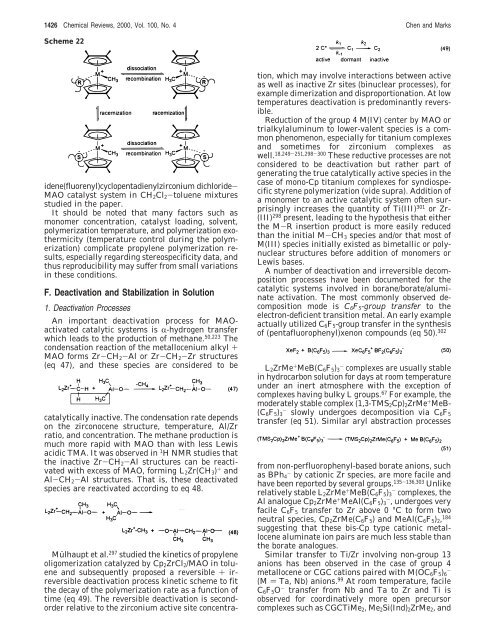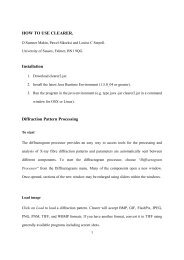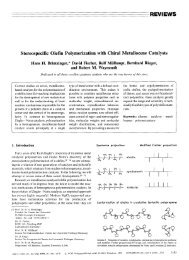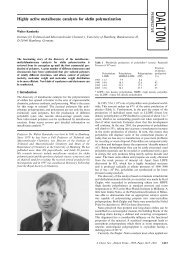Cocatalysts for Metal-Catalyzed Olefin Polymerization: Activators ...
Cocatalysts for Metal-Catalyzed Olefin Polymerization: Activators ...
Cocatalysts for Metal-Catalyzed Olefin Polymerization: Activators ...
You also want an ePaper? Increase the reach of your titles
YUMPU automatically turns print PDFs into web optimized ePapers that Google loves.
1426 Chemical Reviews, 2000, Vol. 100, No. 4 Chen and Marks<br />
Scheme 22<br />
idene(fluorenyl)cyclopentadienylzirconium dichloride-<br />
MAO catalyst system in CH2Cl2-toluene mixtures<br />
studied in the paper.<br />
It should be noted that many factors such as<br />
monomer concentration, catalyst loading, solvent,<br />
polymerization temperature, and polymerization exothermicity<br />
(temperature control during the polymerization)<br />
complicate propylene polymerization results,<br />
especially regarding stereospecificity data, and<br />
thus reproducibility may suffer from small variations<br />
in these conditions.<br />
F. Deactivation and Stabilization in Solution<br />
1. Deactivation Processes<br />
An important deactivation process <strong>for</strong> MAOactivated<br />
catalytic systems is R-hydrogen transfer<br />
which leads to the production of methane. 50,223 The<br />
condensation reaction of the metallocenium alkyl +<br />
MAO <strong>for</strong>ms Zr-CH2-Al or Zr-CH2-Zr structures<br />
(eq 47), and these species are considered to be<br />
catalytically inactive. The condensation rate depends<br />
on the zirconocene structure, temperature, Al/Zr<br />
ratio, and concentration. The methane production is<br />
much more rapid with MAO than with less Lewis<br />
acidic TMA. It was observed in 1 H NMR studies that<br />
the inactive Zr-CH2-Al structures can be reactivated<br />
with excess of MAO, <strong>for</strong>ming L2Zr(CH3) + and<br />
Al-CH2-Al structures. That is, these deactivated<br />
species are reactivated according to eq 48.<br />
Mülhaupt et al. 297 studied the kinetics of propylene<br />
oligomerization catalyzed by Cp2ZrCl2/MAO in toluene<br />
and subsequently proposed a reversible + irreversible<br />
deactivation process kinetic scheme to fit<br />
the decay of the polymerization rate as a function of<br />
time (eq 49). The reversible deactivation is secondorder<br />
relative to the zirconium active site concentra-<br />
tion, which may involve interactions between active<br />
as well as inactive Zr sites (binuclear processes), <strong>for</strong><br />
example dimerization and disproportionation. At low<br />
temperatures deactivation is predominantly reversible.<br />
Reduction of the group 4 M(IV) center by MAO or<br />
trialkylaluminum to lower-valent species is a common<br />
phenomenon, especially <strong>for</strong> titanium complexes<br />
and sometimes <strong>for</strong> zirconium complexes as<br />
well. 18,249-251,298-300 These reductive processes are not<br />
considered to be deactivation but rather part of<br />
generating the true catalytically active species in the<br />
case of mono-Cp titanium complexes <strong>for</strong> syndiospecific<br />
styrene polymerization (vide supra). Addition of<br />
a monomer to an active catalytic system often surprisingly<br />
increases the quantity of Ti(III) 301 or Zr-<br />
(III) 298 present, leading to the hypothesis that either<br />
the M-R insertion product is more easily reduced<br />
than the initial M-CH3 species and/or that most of<br />
M(III) species initially existed as bimetallic or polynuclear<br />
structures be<strong>for</strong>e addition of monomers or<br />
Lewis bases.<br />
A number of deactivation and irreversible decomposition<br />
processes have been documented <strong>for</strong> the<br />
catalytic systems involved in borane/borate/aluminate<br />
activation. The most commonly observed decomposition<br />
mode is C6F5-group transfer to the<br />
electron-deficient transition metal. An early example<br />
actually utilized C6F5-group transfer in the synthesis<br />
of (pentafluorophenyl)xenon compounds (eq 50). 302<br />
L2ZrMe + MeB(C6F5)3 - complexes are usually stable<br />
in hydrocarbon solution <strong>for</strong> days at room temperature<br />
under an inert atmosphere with the exception of<br />
complexes having bulky L groups. 67 For example, the<br />
moderately stable complex (1,3-TMS2Cp)2ZrMe + MeB-<br />
(C6F5)3 - slowly undergoes decomposition via C6F5<br />
transfer (eq 51). Similar aryl abstraction processes<br />
from non-perfluorophenyl-based borate anions, such<br />
as BPh4 - by cationic Zr species, are more facile and<br />
have been reported by several groups. 135-136,303 Unlike<br />
relatively stable L2ZrMe + MeB(C6F5)3 - complexes, the<br />
Al analogue Cp2ZrMe + MeAl(C6F5)3 - , undergoes very<br />
facile C6F5 transfer to Zr above 0 °C to <strong>for</strong>m two<br />
neutral species, Cp2ZrMe(C6F5) and MeAl(C6F5)2, 184<br />
suggesting that these bis-Cp type cationic metallocene<br />
aluminate ion pairs are much less stable than<br />
the borate analogues.<br />
Similar transfer to Ti/Zr involving non-group 13<br />
anions has been observed in the case of group 4<br />
metallocene or CGC cations paired with M(OC6F5)6 -<br />
(M ) Ta, Nb) anions. 99 At room temperature, facile<br />
C6F5O - transfer from Nb and Ta to Zr and Ti is<br />
observed <strong>for</strong> coordinatively more open precursor<br />
complexes such as CGCTiMe2,Me2Si(Ind)2ZrMe2, and






